It is a little surreal, looking at where the Mega Archive is presently at in Sega Genesis/Mega Drive history and realizing it was almost exactly thirty years ago to the day that many of these games debuted. Not to go on a spiel about walking three miles in the snow uphill both ways to get to school and back, possibly because my diplodocus was in the shop, but it does highlight how video games have existed for a long time now and even the big furore surrounding the 16-bit Sega vs. Nintendo war is rapidly receding into the distant past. I'm not exactly uncovering Tutenkhamun's tomb by spending 500 words waxing lyrical about Cool Spot and whatever historically significant adventures he may have had in "Uncola World" but I am starting to appreciate the length of time between then and now and how video games have changed so much in the meanwhile. Well, unless you play a lot of Indie throwbacks, in which case much of what follows will probably seem oddly familiar.
We've got some curious customers to scrutinize for this entry as we incorporate all of March 1993's Japan premieres (including a few region exclusives; increasingly rare for the Mega Drive) before moving into our first April batch. There's a mix of genres from the ever-present platformers to strategy games, brawlers, racers, and—best of all—only a single sports game. Next month, I'll be taking a brief vacay to the land of CD-ROMs with another installment of the Mega Archive CD, getting us all caught up in what's been going on with the Sega CD system across the first four months of 1993. Is it still mostly painful FMV games where B-movie actors yell insults at you? You might be pleasantly surprised to discover it's not (mostly).
Before we start, we gotta revisit the Mega Archive archive, now horribly distorted beyond repair:
Part I: 001-020 (Oct '88 - Dec '89) | Part II: 021-035 (Dec '89 - Mar '90) | Part III: 036-050 (Apr '90 - Jul '90) |
| Part IV: 051-065 (Aug '90 - Oct '90) | Part V: 066-080 (Oct '90 - Dec '90) | Part VI: 081-098 (Dec '90) |
Part VII: 099-115 (Jan '91 - Mar '91) | Part VIII: 116-130 (Mar '91 - Apr '91) | Part IX: 131-145 (May '91 - Jun '91) |
Part X: 146-160 (Jun '91 - Jul '91) | Part XI: 161-175 (Jul '91 - Aug '91) | Part XII: 176-190 (Aug '91 - Sep '91) |
Part XIII: 191-205 (Oct '91 - Nov '91) | Part XIV: 206-220 (Nov '91) | Part XV: 221-240 (Dec '91) |
Part XVI: 241-255 (Jan '92 - Feb '92) | Part XVII: 256-270 (Mar '92 - Apr '92) | Part XVIII: 271-285 (Apr '92 - Jun '92) |
Part XIX: 286-300 (Jul '92 - Aug '92) | Part XX: 301-310 (Aug '92 - Sep '92) | Part XXI: 311-320 (Sep '92 - Oct '92) |
Part XXII: 321-330 (Oct '92) | Part XXIII: 331-340 (Oct '92 - Nov '92) | Part XXIV: 341-350 (Nov '92 - Dec '92) |
Part XXV: 351-360 (Dec '92) | Part XXVI: 361-370 (Dec '92) | Part XXVII: 371-381 (Dec '92) |
Part XXVIII: 382-390 (Jan '93 - Feb '93) | Part XXIX: 391-400 (Feb '93) | Part XXX: 401-410 (Mar '93) |
| Part XXXI: 411-420 (Mar '93 - Apr '93) | Part XXXII: 421-430 (???) | Part XXXIII: 431-440 (???) |
| Part XXXV: 441-450 (???) | Part XXXVI: 451-460 (???) | Part XXXVII: 461-470 (???) |
Part XXXI: 411-420 (March '93 - April '93)
411: Tony La Russa Baseball
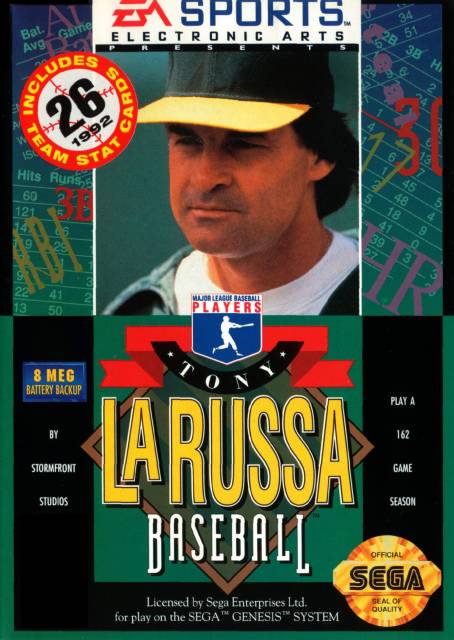
- Developer: Beyond Software
- Publisher: Electronic Arts
- JP Release: N/A
- NA Release: March 1993
- EU Release: N/A
- Franchise: Tony La Russa
- Genre: Baseball
- Theme: Baseball
- Premise: Baseball
- Availability: Nope. Simulation-style, so you're better off with something newer.
- Preservation: Are you trying to tell me Tommy Lasorda and Tony La Russa are different people? Why does one of them sound like a palette swap of the other? Anyway, both these gentlemen graced the Sega Genesis with a baseball game and thankfully they were released far enough apart that parents didn't accidentally get the bad one. Which one is the bad one? Hell if I know. The Tony La Russa Baseball franchise began on the Commodore 64 in 1991 as Tony La Russa's Ultimate Baseball (I guess they realized this was a dumb title if they were going to be making sequels) and this Genesis game is sort of an upgraded port/adaptation of that original. Electronic Arts brought it over to the Genesis because it was one of the few sports they didn't already represent; they would do the same with a number of baseball franchises from different developers, rather than stick to one iterative franchise like Madden NFL or NHL. Like many PC-to-console sports game conversions, it skirts the line between simulation and arcade by offering both modes as options when starting a new game. Developers Beyond Software would change their name later the same year this game released, becoming known by the retroactively-unfortunate Stormfront Studios: an unholy union of jocks and geeks, their two biggest properties are Tony La Russa Baseball and the D&D-licensed games they produced with SSI and EA including the pioneering MMO Neverwinter Nights (not to be confused with the later BioWare series) and the action-RPG Forgotten Realms: Demon Stone.
- Wiki Notes: Skeleton page, so it needed a little of everything.
412: Splatterhouse 3
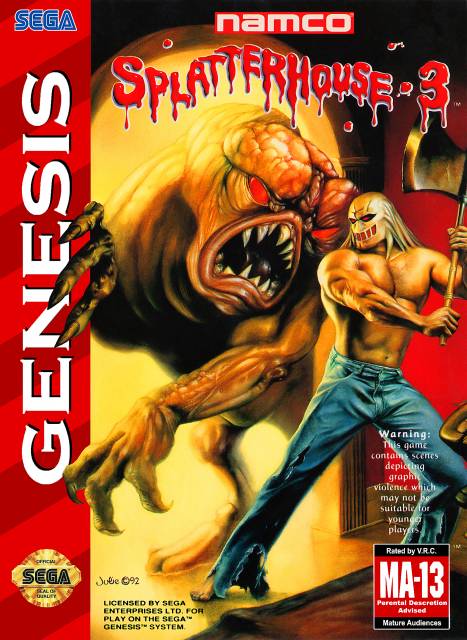
- Developer: Now Production
- Publisher: Namco
- JP Release: 1993-03-19
- NA Release: August 1993
- EU Release: N/A
- Franchise: Splatterhouse
- Genre: Brawler
- Theme: Horror
- Premise: It's a horror game that plays like a belt-scrolling street brawler. A "Final Fright", if you will.
- Availability: Iffy. Namco's not seen fit to make the Splatterhouse series available to modern audiences, possibly because of its controversially gory content, but if you find that 2010 reboot for 360/PS3 in the wild it contains all the older Splatterhouse games as bonus content, including this one.
- Preservation: Splatterhouse 3 is the second Mega Drive-exclusive Splatterhouse sequel, Namco figuring that Sega's edgy console was a perfect home for its Friday the 13th-adjacent (so, Saturday the 14th?) charms. Staying true to the original's roots as a challenging arcade game, Splatterhouse 3 introduces a timed aspect that determines the ending the player receives: for the best result, you gotta be quick about smashing all those ghouls in the face with a two-by-four. As before with Splatterhouse 2 [MA XIX], Namco brought in frequent collaborators Now Production (a.k.a. Nowpro) to develop the game. The two would have one more collaboration for the Mega Drive, which is a game we'll dig into once we reach the summer of '93.
- Wiki Notes: We had a very robust page already, just needed some minor formatting and the Japanese release/box art added.
413: Genghis Khan II: Clan of the Gray Wolf / Aoki Ookami to Shiroki Meshika: Genchou Hishi
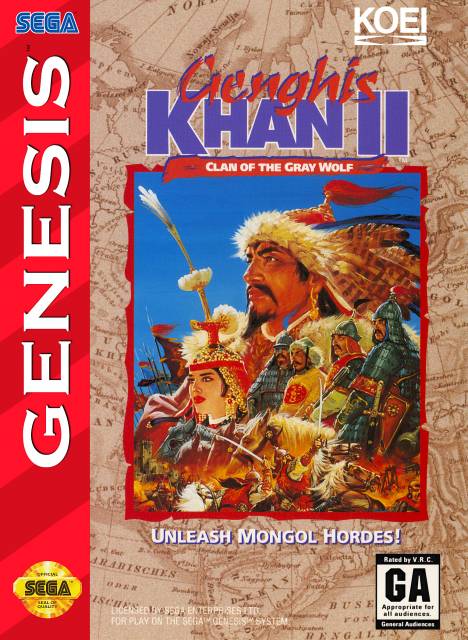
- Developer: Koei
- Publisher: Koei
- JP Release: 1993-03-25 (as Aoki Ookami to Shiroki Meshika: Genchou Hishi)
- NA Release: 1993 (as Genghis Khan II: Clan of the Gray Wolf)
- EU Release: N/A
- Franchise: Genghis Khan
- Genre: Strategy
- Theme: Medieval Warfare
- Premise: Follow the adventures of one of the most successful warlords that ever lived, defiling what he defiles and eating whom he eats, in this historical warfare sequel made in Koei's inimitable heavy numbers-and-menus strategy game style.
- Availability: Sorta? I'd say it's still available on the Wii U eShop but they're days away from shutting that thing down.
- Preservation: His name's on the box but much like Koei's more famous Nobunaga's Ambition series you actually have several flavors of Mongol warlord to choose from and that's just the first scenario. After uniting the Mongols as Temujin or one of his rivals, you then take to the global stage with various 12th-century world leaders to back. Want to spend hours helping Genghis Khan clinch a victory in his homeland only to crush him as Richard the Lionhearted? Go nuts. History's malleable like that. Despite the numeral, this is the only Genghis Khan title that came to Mega Drive: its predecessor was for NES/DOS (at least, those are the only two versions that got localized), and its sequel Genghis Khan: Aoki Ookami to Shiroki Mejika IV was a Japan-only PC and PS1 game. If you're curious why the sequel is a IV, Clan of the Gray Wolf is actually the third game in the series rather than the second: Koei just pulled a Final Fantasy and didn't bother including the Japan-only games in the western numbering system. Those rascals.
- Wiki Notes: SNES double-dip and someone already uploaded MD screenshots, so all it needed were a few releases.
414: Battletoads
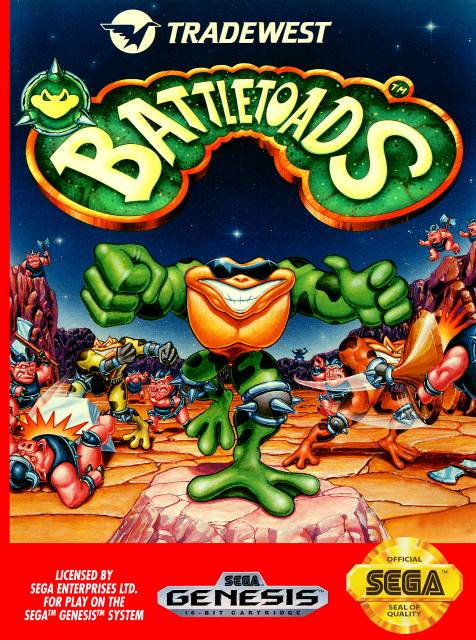
- Developer: Arc System Works
- Publisher: Tradewest (NA) / Sega (JP/EU)
- JP Release: 1993-03-26
- NA Release: March 1993
- EU Release: July 1993
- Franchise: Battletoads
- Genre: Brawler / Action
- Theme: Masochismo (noun, to have attacks on one's masculine pride be the motivator to suffer through an absurdly punishing game)
- Premise: The 'Toads leapfrog into action to foil the plans of the Dark Queen after she kidnaps Princess Angelica and their buddy Pimple, chasing her spaceship's trail to the dangerous planet of Ragnarok's World.
- Availability: You can play the NES original on Rare Replay, available on Xbox One and Xbox Series S/X.
- Preservation: Inspired by the Ninja Turtles, Rare put together the world's finest torture device this side of a Ghouls N' Ghosts with the Battletoads—a trio of martial artist amphibians, rather than a quartet—and their nemesis, the sarcastic Dark Queen. Rare put a special emphasis on cartoon violence in the art direction, having the Battletoads' limbs grow comically large whenever they dealt the finishing blow to an enemy, and found a way to keep players guessing by having every level take on a different format. The first lures you in with its straightforward brawling, but later levels have you navigating tough obstacle courses on speedbikes or racing a CPU up a perilous rotating tower. The Mega Drive version of Battletoads, which was first released in 1991 for NES, came about around the same time that the SNES would receive the franchise's first sequel, Battletoads in Battlemaniacs. 1993 would also see the release of the second sequel Battletoads & Double Dragon, which had the Battletoads teaming up with Technos's Dragon brothers Billy and Jimmy, which had a same-year Mega Drive port we'll be covering at some point soon. This is our second Rare game after Championship Pro-Am [MA XXVII] but the first, as far as I can tell, to have Arc System Works come in to develop the Mega Drive port. The future anime fighter mavens only popped up on Mega Drive twice—this and an upcoming Sailor Moon game—but would develop something for almost every Sega system including, for some reason, a heavy presence on the educational Sega Pico.
- Wiki Notes: Unsurprisingly, we had a pretty decent page for Battletoads already. Just needed some MD-specific screenshots and releases.
415: Doraemon: Yume Dorobou to 7 Nin no Gozans
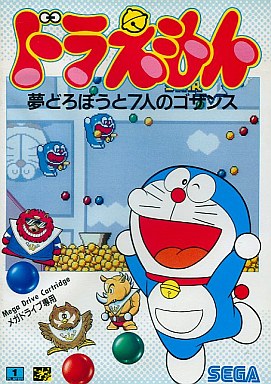
- Developer: Sega
- Publisher: Sega
- JP Release: 1993-03-26
- NA Release: N/A
- EU Release: N/A
- Franchise: Doraemon
- Genre: Platformer
- Theme: Literal Dream Logic
- Premise: Some kind of weird interdimensional lion has stolen everyone's dreams with a magical orb so Doraemon chases after it into Dream World via the Anywhere Door to recover them. This shit is like a regular Tuesday for Doraemon.
- Availability: Nah. Licensed game.
- Preservation: Everybody's friend Doraemon is a robotic cat that travels backwards from the future to screw around with a kid called Nobita and his friends. The Doraemon manga began at the dawn of the 1970s and has been a fixture of Japanese kids' entertainment ever since, with multiple anime and film adaptations. Games were a natural home for a hero with an impressive array of gadgets but it wouldn't be until 1993 until Doraemon hit a Sega console—there was also a Sega-made redemption game released that year, as well as a couple of Sega Pico games and a Game Gear game. (Doraemon games were a far more common sight on Nintendo systems, where I guess their family-friendly vibe was a better fit.) Either way, this unremarkable licensed platformer is the only time we'll be seeing Doraemon on this feature (though if we ever get around to covering the Pico (unlikely) he shows up an incredible thirteen times on there). If you're curious about the game itself, since I've mostly avoided talking about it, it's kinda like if you crossed SMB2/Doki Doki Panic with an Alex Kidd game; the latter clearly Sega's contribution. That also means every boss fight is a janken match, which is probably the worst thing they could've carried over.
- Wiki Notes: This one threw me for a loop because the page had a translated title, which we don't generally use for games that never received an official localization (though they'll often have those titles for fan translations, which is what our editors will sometimes use instead; weird thing is, I don't think this game even has a fan translation). As such, took me a little while to find it on our wiki. Otherwise, just needed some body text and a little bit of sprucing up.
416: OutRun 2019
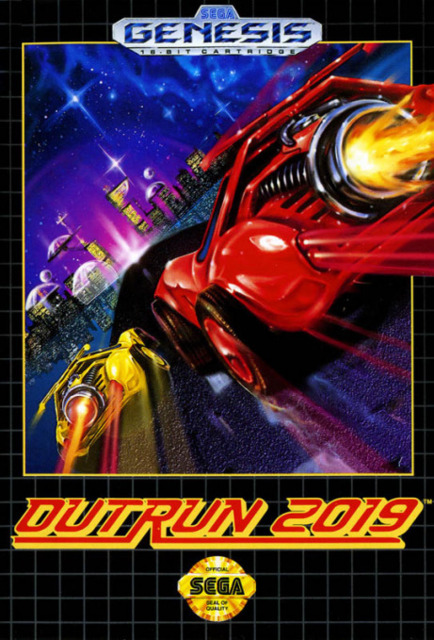
- Developer: Hertz
- Publisher: Sega (NA/EU) / SIMS (JP)
- JP Release: 1993-03-26
- NA Release: March 1993
- EU Release: April 1993
- Franchise: OutRun
- Genre: Racing
- Theme: Sci-fi
- Premise: Street-ready rocket cars by 2019? We had such high hopes.
- Availability: Nothing. Not even a 2019 rerelease.
- Preservation: Once upon a time, 2019 was considered the distant future (I know) so this game reimagines Sega's venerable super-scaler arcade racer in a more F-Zero/WipEout style. It still retains OutRun's most prominent feature, excepting the blonde sitting in the passenger seat who I guess got replaced by a gynoid or a coffee maker or something, which is how each of the game's four courses eventually split into multiple distinct paths each offering their own challenges to overcome. OutRun 2019 also has a few secret shortcuts that take some experimentation and courage to find. Most sources put SIMS, the Sega-Sanritsu collab studio, as the developer but they were only the Japanese publishers and were subcontractors for the real developers, Hertz, a game subsidiary of an engineering company. Hertz were also behind the original Mega Drive port of OutRun, but this would sadly be their last game.
- Wiki Notes: No text whatsoever, which is rare. To paraphrase Ghostbusters: yes, this page has no deck. Did already have some screenshots and releases though, so I appreciate that.
417: Cool Spot
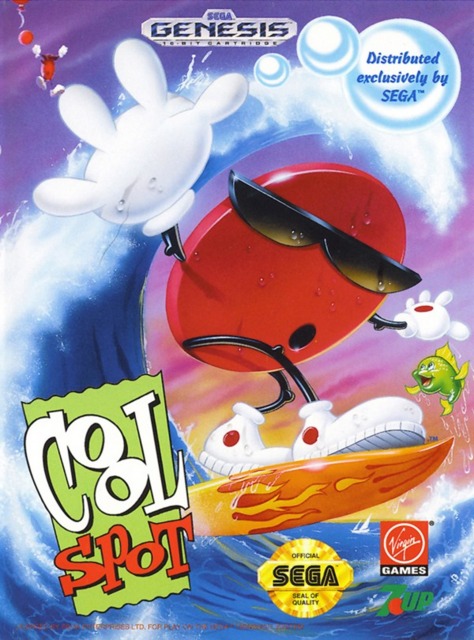
- Developer: Virgin Interactive
- Publisher: Virgin Interactive
- JP Release: 1994-02-18
- NA Release: April 1993
- EU Release: June 1993
- Franchise: Spot
- Genre: Platformer
- Theme: Mediocre Lemon-Lime Sodas
- Premise: Cool Spot's friends have been captured (I guess they weren't as cool as Cool Spot if they got kidnapped so easily) and it's up to a soft drink mascot to save a bunch of other soft drink mascots. The stakes have literally never been higher.
- Availability: Licensed game, so nothin' doin'.
- Preservation: Most advergames are given the treatment they deserve by the video game industry, which is to say drab and uninspired adventures which radiate a sense of weary obligation for the sake of a paycheck, but Cool Spot was a rare exception. Developed by David Perry (not the Journey guy) Cool Spot had a lot of tech that would later find its way into Perry's flagship franchise for his subsequent Shiny Entertainment venture, Earthworm Jim. Scored by future Internet Main Character Tommy Tallarico, Cool Spot's like a neat "before they were famous" look at some rising stars of '90s game development. I also think it's an exceptional platformer but time may have taken its toll on that opinion over the years; for one, it has that circuitous collectathon mindset that works wonders in a 3D context but less so in a labyrinthine 2D game where you spend whole minutes backtracking to find the shit you're missing. Cool Spot was enough of a hit to spawn a Genesis/Saturn/PlayStation sequel, Spot Goes to Hollywood, in 1995 which I guess we'll have to talk about eventually. Fun Fact #1: They downplayed all mentions of 7 Up in the European versions of this game because the Spot wasn't known as 7 Up's mascot over here—it's all Fido Dido all day for us Eurotrash. We'll talk more about Fido Dido when we cover his video game that never came out, so never. Fun Fact #2: Despite being a 7 Up game, the graphics are full of sprites. How messed up is that?
- Wiki Notes: SNES double-dip, so just some releases.
418: Cyborg Justice
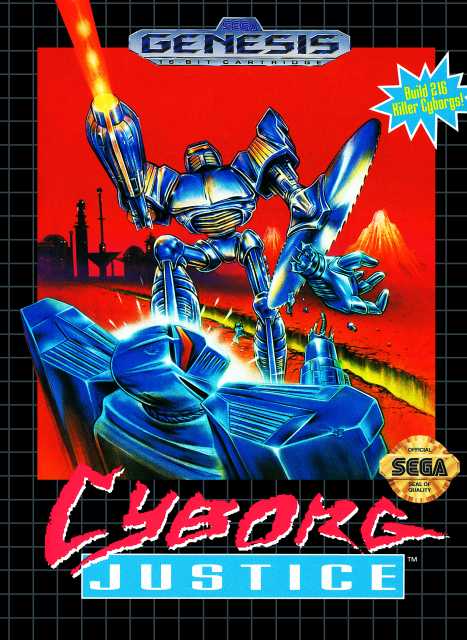
- Developer: Novotrade
- Publisher: Sega
- JP Release: N/A
- NA Release: April 1993
- EU Release: April 1993
- Franchise: N/A
- Genre: Brawler
- Theme: Working Title For Robocop
- Premise: Robots scoop out the brain of a crashlanded human astronaut, stick it into a robot suit, and try to mind control it into doing their bidding. Why they would do this is anyone's guess, but ol' Buzz ain't having any of it and takes to the streets to show these mechanical mooks what humanity is all about (mostly punching).
- Availability: Nah, no-one's reviving this one, robot suit or otherwise.
- Preservation: Our second brawler for this entry is a rare sci-fi take from our Hungarian buds Novotrade. We last saw Novotrade with the first game in their considerably more successful franchise Ecco the Dolphin; the next time we see them will also be for an Ecco game, so I guess they figured it was worth sticking to what worked. One neat thing about Cyborg Justice, which is a pretty generic belt-scroller otherwise, is that you can repurpose the dismembered limbs and body parts of your machine foes to upgrade yourself. Liked the cool drill arm that one guy had? Well, now it's yours. I'm not sure we'll see another application of this feature until Deck13's The Surge many years later, unless there's a whole sub-genre of limb-repurposing games I've missed out on.
- Wiki Notes: Little bit of text cleanup and a shiny new European release.
419: The Flintstones
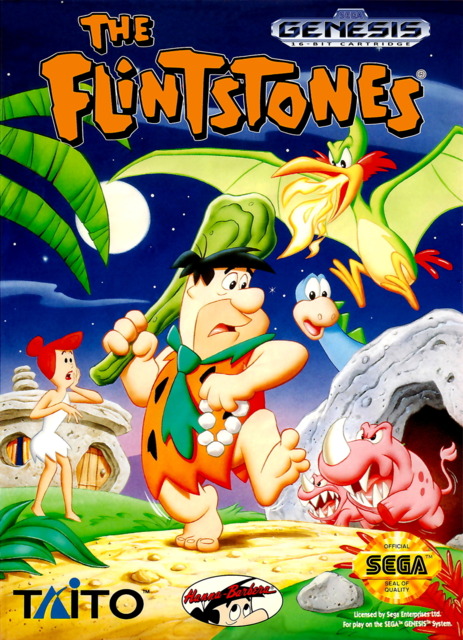
- Developer: Santos
- Publisher: Taito
- JP Release: 1993-11-19
- NA Release: April 1993
- EU Release: June 1993
- Franchise: The Flintstones
- Genre: Platformer
- Theme: A series of beleaguered animal appliances mugging to the camera. I'm rooting for their eventual Spartacus-style slave uprising. "It's a living"? More like it's a killing.
- Premise: Blue-collar worker caveman Fred Flintstone is lazy and doesn't treat his wife very well. That applies to this game, every other game, and every episode of the show.
- Availability: Nope. Don't know how many people are eagerly anticipating a Hanna-Barbera version of The Disney Afternoon Collection. Probably some sickos out there.
- Preservation: "Flintstones, meet the Flintstones." I never understood that lyric. How can the Flintstones meet themselves? Or is it asking them to take a long, hard look in the mirror? Either way, the '60s show remained consistently popular for decades afterwards thanks to syndication and there was a brief flurry of activity around the license in the early 1990s after the announcement of a live-action movie (due 1994, and yes there was a game based on that too, and yes we'll be covering it on here eventually). Taito was hanging onto it for whatever reason and decided to put it to use both here and on the SNES with two separate releases (those Nintendoheads got something called The Treasure of Sierra Madrock, presumably also starring Humphrey Boquartz and Walter Hustone). It's a pretty traditional 2D platformer though certainly not a bad one; I'd say it's of a similar quality as the Mickey Mouse Illusion games, with some neat features like platform mantling and vehicle levels (which were still on-foot, of course). Weirdly, the Santos that made this is a different Santos than the one that became Sega subsidiary Mega Soft. I know, a Santos that's not what it claims to be, big shocker.
- Wiki Notes: As is sometimes the case with these non-subtitled TV adaptations, we had a page that conflated multiple games: this one, and one made by Krisalis/Teque for European home computers. Though they have similar structures, there's a considerable difference in quality and content length. I removed all references to the Mega Drive game from that page and then made a whole new page for it.
420: X-Men
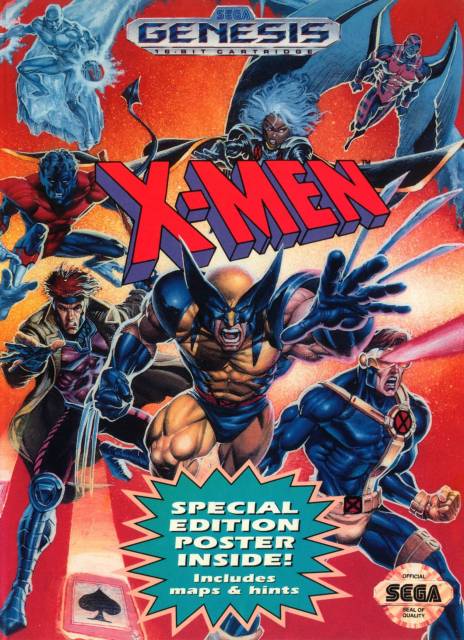
- Developer: Western Technologies
- Publisher: Sega
- JP Release: N/A
- NA Release: April 1993
- EU Release: June 1993
- Franchise: Marvel's X-Men
- Genre: Platformer / Brawler
- Theme: What if the civil rights movement but Dr. Martin Luther King Jr. had eye lasers. I bet a "I Have a Beam" speech would've gone down a lot differently.
- Premise: The X-Men must band together after the Danger Room goes haywire and traps them inside. Only the boys though; the girls can be helpers or something.
- Availability: Nope. Licensed. Probably aren't enough good 16-bit X-Men games to bother with a retro compilation either.
- Preservation: Marvel characters have been consistently popular inside and out of comics fandom even before they took over the whole movie industry, but X-Men in particular really hit a cultural peak in the 1990s thanks to the Fox Kids cartoon. Many games took a swing at what seems like one of the easiest slowballs in comic book licenses; the X-Men's powers are so varied that you make a game perfectly suited to your budget and technical expertise, as opposed to a Spider-Man or Superman who have more extreme powers that'd be much trickier to convey in video game form (not that it stopped a deluge of Webslinger games regardless). For me personally, though, the X-Men really only hit their stride in video game form with the X-Men Legends loot-RPGs with most of the previous games being too generic for their own good. That goes for this game too, which has you select between Wolverine (bub), Gambit (mon ani), Nightcrawler (mein gott), and Cyclops (too boring to have a catchphrase). Storm, Rogue, Jean Grey, and the rest appear as screen-clearing "assist" characters that work essentially the same as smart bombs in shoot 'em ups or that missile launcher cop in Streets of Rage. I've heard people swear by this game, and from what little I've played it's certainly more palatable than those Acclaim games, but "getting stuck in the Danger Room" is always the laziest excuse for a X-Men story. It's like when TNG has a Holodeck episode and I just feel my hand reaching to the "skip episode" button on my streaming device.
- Wiki Notes: Just needed a European release. The last editor included a bunch of boss strategies in the body text so I shipped that mess to the Guides section. Good thing everyone uses (and knows about) our wiki's Guides.
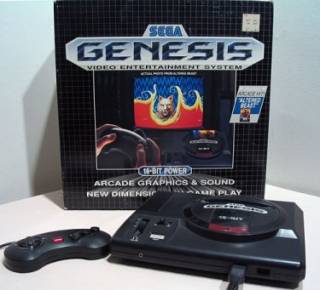
Log in to comment